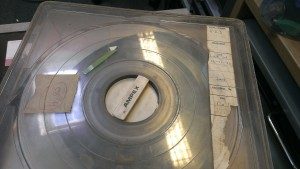Sometimes genuine rarities turn up at the Greatbear studio. Our recent acquisition of four reels of ‘missing, believed wiped’ test recordings of cult BBC TV show The Old Grey Whistle Test is one such example.
It is not only the content of these recordings that are interesting, but their form too, because they were made on 1” Type A videotape.
The Ampex Corporation introduced 1” Society of Motion Picture and Television Engineers (SMPTE) type A videotape in 1965.
The 1″ Type A was ‘one of the first standardised reel-to-reel magnetic tape formats in the 1 inch (25 mm) width.’ In the US it had greatest success as an institutional and industrial format. It was not widely adopted in the broadcast world because it did not meet Federal Communications Commission (FCC) specifications for broadcast videotape formats—it was capable of 350 lines, while the NTSC standard was 525, PAL and SECAM were 625. (Note: upcoming conference ‘Standards, Disruptions and Values in Digital Culture and Communication‘ taking place November 2015).
According the VT Old Boys website, created by ex-BBC engineers in order to document the history of videotape used at the organisation, 2″ Quadruplex tape remained very much the norm for production until the end of the 1970s.
Yet the very existence of the Old Grey Whistle Test tapes suggests type A videotape was being used in some capacity in the broadcast world. Perhaps ADAPT, a project researching British television production technology from 1960-present, could help us solve this mystery?
As these things go, type A was followed by Type B, with this model developed by the German company Bosch. Introduced in 1976, Type B was widely adopted in continental Europe, but not in UK and USA which gravitated toward the type C model, introduced by SONY/ Ampex, also in 1976. Type C then became the professional broadcast standard and was still being used well into the 1990s. It was able to record high quality composite video, and therefore had an advantage over component videos such as Betacam and MII that were ‘notoriously fussy and trouble-prone.‘ Type C also had fancy functions like still, shuttle, variable-speed playback and slow motion.
From a preservation assessment point of view, ‘one-inch open reel is especially susceptible to risks associated with age, hardware, and equipment obsolescence. It is also prone to risks common to other types of magnetic media, such as mould, binder deterioration, physical damage, and signal drop-outs.’
The Preservation Self-Assessment Programme advise that ‘this format is especially vulnerable, and, based on content assessment, it should be a priority for reformatting.’
AMPEX made over 30 SMPTE type A models, the majority of which are listed here. Yet the number of working machines we have access to today is few and far between.
In years to come it will be common for people to say ‘it takes four 1” Type A tape recorders to make a working one’, but remember where you heard the truism first.
Harvesting several of these hulking, table-top machines for spares and working parts is exactly how we are finding a way to transfer these rare tapes—further evidence that we need to take the threat of equipment obsolescence very seriously.